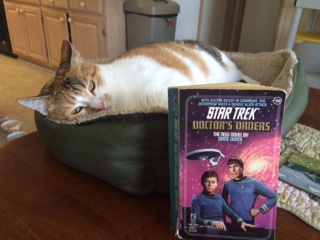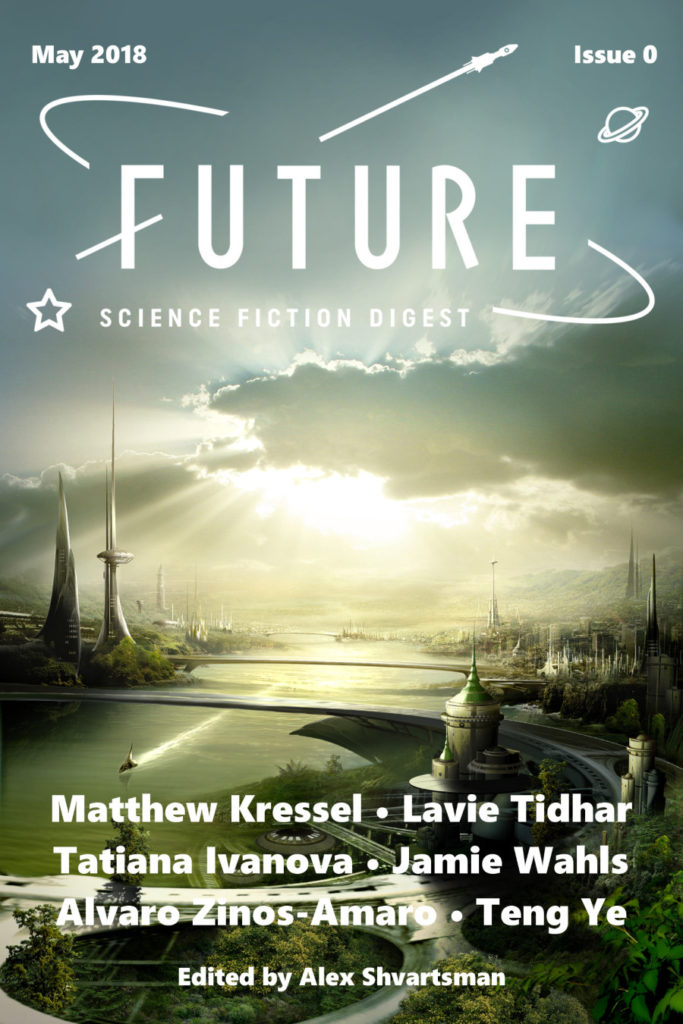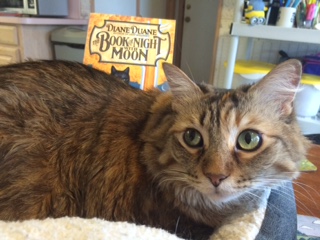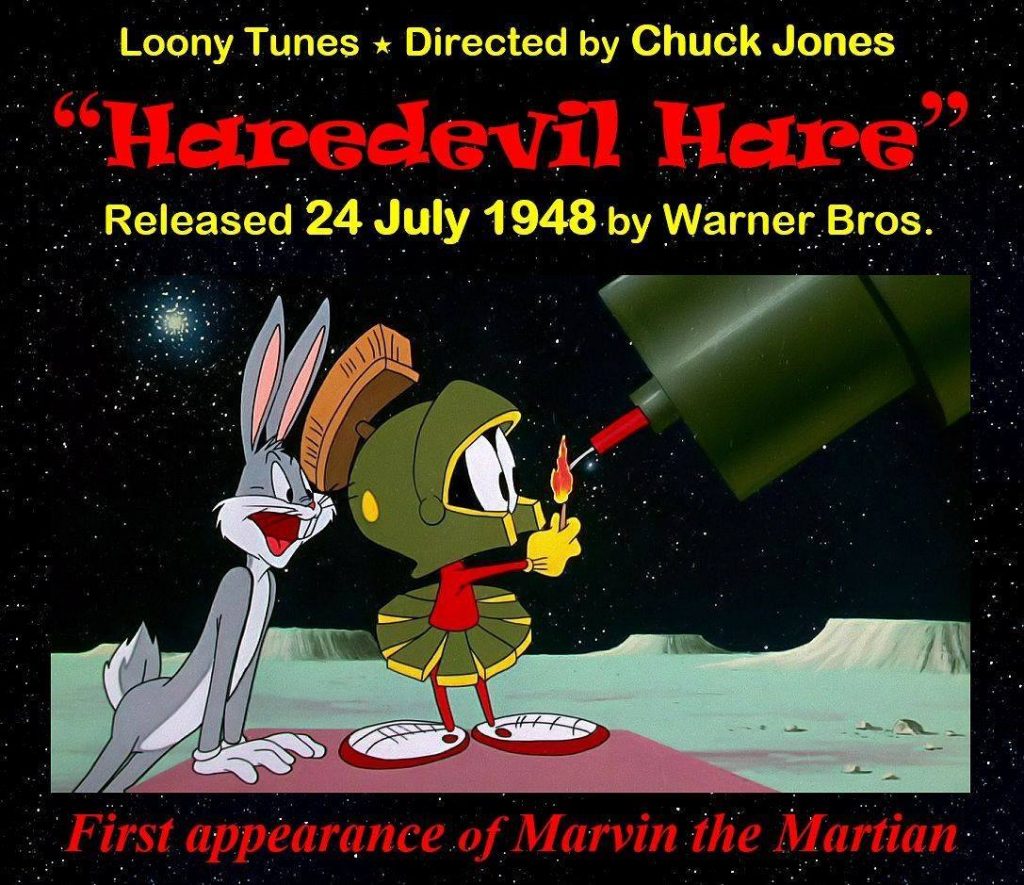By Robin Anne Reid:
NOTE: Spoilers for a number of Tepper’s novels occur throughout the essay.
WARNING: For references to rape and abuse of young women as an element of Tepper’s novels.
The Fan
I found my first Tepper novel in the early 1980s. I remember standing in the University of Washington bookstore reading the opening pages of King’s Blood Four, the first of what would become the nine-novel triple trilogy The True Game. Had Tepper’s work continued in that vein, interesting world-building with a male protagonist, I am not sure I would have become such a fervent fan.
However, even this early novel had threads of the feminist themes Tepper would develop in more detail in her later work. Peter starts out as a typical fantasy orphan hero. He is a young man, a foundling, raised in an all-male environment, who almost immediately embarks on a quest. The setting is the world of the True Game where characters have fantastic powers echoing medievalist fantasy conventions. But the initiating event is an attack on King Mertyn in which Peter is used and injured by his male lover, and the outcome of Peter’s journey is learning about the Immutables (those outside the Game who lack any of the powers valued in the Game) and meeting his mother (not his father!). Those differences were different enough to keep me reading the trilogy and keeping an eye out for her other work.[1] I was lucky since she published so many novels so quickly: her entry in Wikipedia lists ten novels published in 1983-1985.
The later trilogies in the True Game series, Mavin’s and Jinian’s, turn away from the male bildungsroman to twist fantasy conventions on multiple levels. Suddenly, as with Anne McCaffrey’s Pern series, I found myself in a science fiction narrative of sorts, a lost colony settled by humans. But even before I read the later trilogies in the True Game series, I found the Marianne Trilogy.

Reading the first in this series put Tepper’s name immediately on my “buy as soon as they appear” list of authors, and that response never changed although some of her later works appeal to me much less than the earlier ones. I tend to be completist when I love an author’s works even if I do not love all of them.[2]
The opening paragraph of Marianne, The Magus, and the Manticore remains one of my favorites:
During the night, Marianne was awakened by a steady drumming of rain, a muffled tattoo as from a thousand drumsticks on the flat porch roof, a splash and gurgle from the rainspout at the corner of the house outside Mrs. Winesap’s window, babbling its music in vain to ears which did not hear. “I hear,” whispered Marianne, speaking to the night, the rain, the corner of the living room she could see from her bed. When she lay just so, the blanket drawn across her lips, the pillow crunched into an exact shape, she could see the amber glow of a lamp in the living room left on to light one corner of the reupholstered couch, the sheen of the carefully carpentered shelves above it, the responsive glow of the refinished table below, all in a kindly shine and haze of belonging there. “Mine,” said Marianne to the room. The lamplight fell on the first corner of the apartment to be fully finished, and she left the light on so that she could see it if she woke, a reminder of what was possible, a promise that all the rooms would be reclaimed from dust and dilapidation. Soon the kitchen would be finished. Two more weeks at the extra work she was doing for the library and she’d have enough money for the bright Mexican tiles she had set her heart upon. (1).
This scene is vital, so present in its appeal to the senses (the sounds of the rain—a sound I often lie awake listening to—the light reflecting off bookshelves, a “refinished table,”), that I become immersed in the world immediately. Marianne’s achievement differs greatly from that of most fantasy novels: she is remodeling an old house and refinishing furniture primarily through her own labor in order to reclaim the color and feel of her childhood home, lost with her parents’ death. The fantasy worlds in this trilogy seem unique (even in the context of Tepper’s work), and I fell in love.
I love Marianne and her momegs, Marjorie and her horses, Mavin’s refusal to compromise, Jinian and her animals, Jinian’s Seven, and the Seven–Carolyn, Agnes, Bettiann, Ophelia, Jessy, Faye, and Sova—in Gibbon’s Decline and Fall.

I love Tepper’s world-creation, the animism and ecological/environmentalist themes in her work, the creativity of her names for characters and animals, and, most of all, her descriptions of trees and forests. Tepper and Tolkien’s work seem so alike to me in their love for trees although I wonder how many readers would see any similarity.
I love the feminist elements (some of them!): my love for Grass is not only because of Marjorie and her horses but because of Marjorie’s quest to save her daughter. An additional feminist elements (which I had not thought of until the early drafts of this essay) are some of the male characters who do not fit the model of heroic (or toxic) masculinity: there are two of them in Grass (Rillibee Chime and Brother Mainoa).[3]
I also (and I’ve not seen many reviews talking about this element!) love the skewering of academia that Tepper does in some of her novels (notably in the True Game series and in Sideshow).

The opening paragraphs of Chapter 1 of Grass are also very high on my list of favorite openings:
Grass!
Millions of square miles of it; numberless wind-whipped tsunamis of grass, a thousand sun-lulled caribbeans of grass, a hundred rippling oceans, every ripple a gleam of scarlet or amber, emerald or turquoise, multicolored as rainbows, the colors shivering over the prairies in stripes and blotches, the grasses—some high, some low, some feathered, some straight—making their own geography as they grow. There are grass hills where the great plumes tower in masses the height of ten tall men; grass valleys where the turf is like moss, soft under the feet, where maidens pillow their heads thinking of their lovers, where husbands lie down and think of their mistresses; grass groves where old men and women sit quite at the end of the day, dreaming of things that might have been, perhaps once were. Commoners all, of course. No aristocrat would sit in the wild grass to dream. Aristocrats have gardens for that, if they dream at all.
Grass. Ruby ridges, blood-colored highlands, wine-shaded glades. Sapphire seas of grass with dark islands of grass bearing great plumy green trees which are grass again. Interminable meadows of silver hay where the great grazing beasts move in slanted lines like mowing machines, leaving the stubble behind them to spring up again in trackless wildernesses of rippling argent (1-2).
Tepper’s books occupy a major part of my “favorites” bookshelves (the ones in my bedroom as opposed to the ones in the library or in my home office or in my office at school). I took this picture of her books stacked up on my bedroom chair the day after I heard of her death.
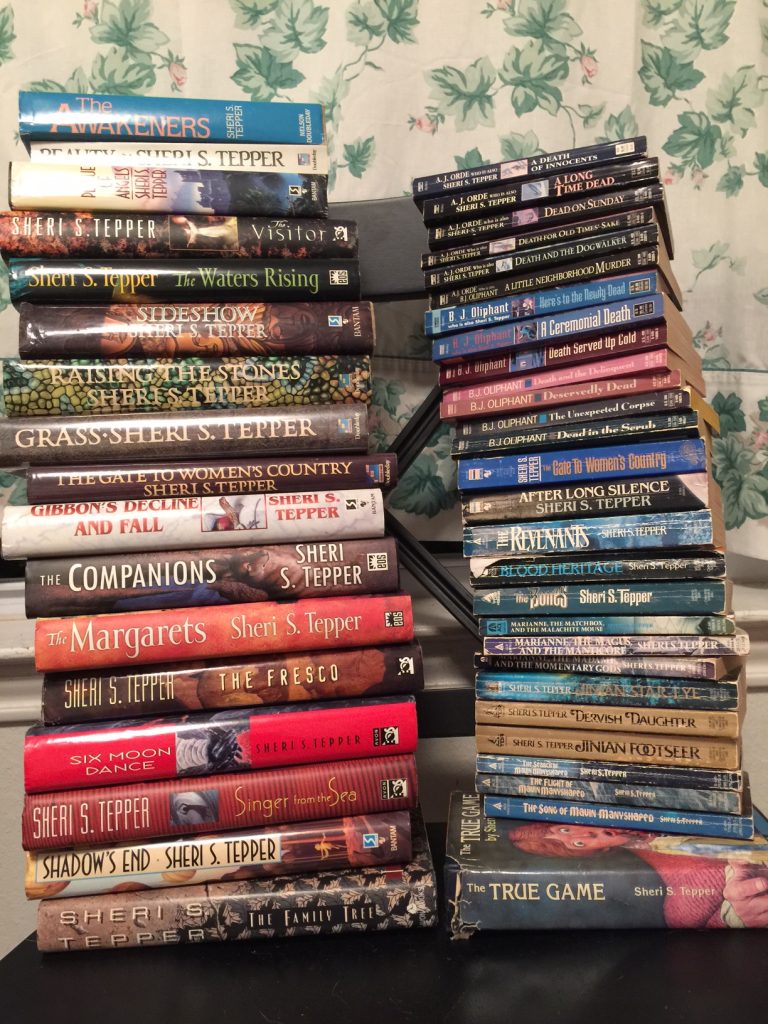
Complications
I wrote Mike to ask if he would be interested in a tribute essay when I learned Sheri Tepper died (October 22, 2016). I began scribbling notes and re-reading some of her books immediately. I got (immediately!) sidetracked (academic habits now ingrained), looking at the scholarship and some critical discussions of her work online. I kept writing, and cutting, and cutting, and writing, until I realized there was a huge amount I wanted to say that I did not have time for and could not yet develop at this point.
My original impulse was to write a fan tribute, but apparently, I am a different kind of fan in 2016 than I was in 1986.[4] I still love (some) of Tepper’s work passionately (and find I am immediately grabbed/immersed in my favorites the moment I open them and read the first paragraphs) even though I can see the validity of many of the criticisms I’ve read. It’s nothing as simple as the suck fairy visiting loved books from my early years (I’ve been reading Tepper, like my other favorite writers, more or less continuously since I found her work thirty-four years ago).
I haven’t yet figured out what has happened although I am beginning to think that the flaws in her work are representative (for me) of some of my own flaws, and some of the flaws in some feminist discourses, and even in the broader American culture. To figure that out, I have to write more, but that has to come later. It’s all connected to my life and experiences, and to the development of Anglo-American feminist speculative fiction and to the current political situation in the U.S.
I wrote the first draft of this piece Wednesday, November 9, nearly twelve hours after it became clear that Donald Trump would win the presidency. The weeks since then have featured events that I think go well beyond what Tepper in even her most “heavy-handed”[5] message fiction thought of writing even though her focus on the dangers of patriarchal authoritarianism, particularly that flavored by a certain flavor of American evangelical fundamentalism (similar to that of the Quiverfull Movement) seems prescient to me.
For some years, I have thought that Tepper, among all the sff writers whose work I know, was the most focused on detailing the threats to women’s rights, especially the right to reproductive choice, that have been the focus of the GOP/Tea Party/social conservative movement the past few decades and which are reading unprecedented heights.[6] These attacks are not the only threats from the social conservatives/GOP who are exulting in the chance to dismantle the legislation and overcome court rulings that addressed systemic sexism, racism, homophobia, and poverty in this country, but I do not see much contemporary sff addressing this particular issue.[7] Tepper’s work is informed by the feminist discourses that are labelled “Second Wave Feminism,” a focus I see as connected to the strengths of her work as well as its flaws.[8]
One of the quotes from her 2008 interview at Strange Horizons is very much reflective of what I’ve been feeling since the election:
SST: Post-apocalyptic, post- or mid-holocaust? You say that’s a grim place to go on a daily basis, yet we both do it every day, don’t we? We’re living in it, Neal. Did you think it was still in the future? Read the daily paper. How do I hold myself there? I read the daily paper. How do I recover? I don’t. Do you?
I discovered Tepper, as I found so many other women writers, after I left academia in 1982 because of sexism in a graduate theatre program where I was doing a Master’s in playwriting (some of my experiences in that graduate program, and others, are why I do not see Tepper’s male antagonists as “straw-men” or unrealistically flat). I spent several years working in low-level clerical jobs and adjunct teaching while reading nothing but feminist theory and women writers. I started by finding and reading all the writers discussed in Joanna Russ’ brilliant How to Supress Women’s Writing, but I also pursued a longtime strategy of mine that predated becoming a feminist: read the bookshelves at libraries and bookstores. If a title or a cover caught my attention, I’d read the first page and see what if it grabbed me.
That’s how I found Tepper.
At the time, I was happy to see the feminist ideas in her work and did not see some of the more problematic aspects relating to Second Wave feminism, particularly in regard to the whiteness of her characters and a view of sex / gender / sexual orientation that defaults to straightness and erases or condemns queerness, flaws that are typical in most cultural productions, of course, as the debates in sff fandom the past few years have highlighted.
I returned to academia in the late 1980s because I could do feminist work in a doctoral program; I did not realize how much intersectional feminist work had been done during the 1970s/1980s until I took my first theory course. That course, and the ones following, changed everything for me. Among other things, critical theory freed me from the limitations of the training I received in my undergraduate days (which excluded popular genres by fiat): Foucault was the one whose work gave me my first tools for writing about science fiction in an academic context (though I had to sort of sneak it into my dissertation). The work by intersectional feminists gave me an entirely different perspective on the sff I loved.
The Academic
As a lifelong fan turned academic who got a Ph.D. in English in part so I could teach sff, I have always been aware of how literary canons are built to exclude. The exclusionary nature of canon-building did not disappear when the 1970s led to so many challenges to the Anglo-American canon of literature: what came about was more an “explosion” of canons.
Thus, there is a feminist sf canon that developed over time, with scholars focusing until recently on the relatively small body of text known as the “seventies feminist utopias” (or the lesbian separatist utopias). Feminist sf scholarship has grown and developed in recent years, and I think the early focus on utopias/dystopias was inevitable given that utopias/dystopias were the only “science fiction” allowed in literary studies at the time.[9] I love some of the novels (particularly those by Joanna Russ and Marge Piercy), but never felt that I had much of anything to say about them as opposed to work by other women sff writers.
My love for Tepper’s work was one of the main reasons that I became interested in the ways in which (some) women writers publishing in the 1980s integrated feminist ideas into their sff in ways that differed from the 1970s feminist utopias (a genre which has nearly disappeared, as Peter Fitting discusses in his excellent essay, “Reconsiderations of the Separatist Paradigm in Recent Feminist Science Fiction,” published in Science Fiction Studies in 1992).
The Marianne trilogy, along with Mavin’s and Jinian’s, and the Arbai Trilogy (Grass, Raising the Stones, and Sideshow are my favorite Teppers.[10] My first major academic presentation in 1991 was on Grass as feminist epic revision of Frank Herbert’s Dune. I have published one article on Tepper’s work in which I talk about the trilogies in the context of feminist utopias, arguing that Tepper’s work explores feminist themes through the concept of “momentary utopias” or “momutes.”[11] The paragraphs below echo some of what I discussed in that essay.
The early trilogies (Marianne’s, Mavin’s, and Jinian’s) are all stories about young women who resist the expectations of their male-dominated families and cultures in ways that differ from the 1970s feminist utopias (with the exception of Woman on the Edge of Time). Since more women began publishing in the 1980s, a greater range of feminist ideas began to appear along with a greater range in genres. Tepper did write one book that can arguably be considered a feminist utopia or dystopia (The Gate to Women’s Country) but I consider most of her work to be feminist speculative fiction with strong fantastic/fantasy elements.
The blend of fantastic worldbuilding and systems of magical powers existing with stories of male family members raping girls, restricting their education, and forcing them into marriages inform these novels. The protagonists resist/escape family pressures but focus on individual resistance for the most part. All the protagonists escape their families but only one is involved in an attempt to change the dominant culture.
Marianne changes her life by changing the time-line (with the help of the momentary gods which she learns how to use by watching her aunt, the villain of the narrative) rather than by changing social expectations or cultural systems. Her power comes from her birth as a Kavi, a member of the hereditary ruling class in Alpenlicht. This trilogy stands out as one of the few of Tepper’s stories in which heterosexual marriage is presented as a positive relationship. I loved it for its worldbuilding, the momegs, the beautiful descriptive prose of the natural world, and the secondary worlds.
Mavin is born into an oppressive extended family, a group of Shapeshifters in the Land of the True Game. Mavin escapes by leaving the Shifter compound, rescuing her younger brother, and, much later, her older sister, and others along the way. Not only does she face rape as she as she is deemed adult (is able to Shift), but the ongoing rape and abuse of her older sister is revealed. Mavin’s trilogy is very much a quest narrative covering twenty years of her life, but she never marries. She loves Himaggery, a wizard she meets in the first novel, but does not stay with him. One of her quests is to rescue him, and shows that they were happy only when shifted into magical beasts (singlehorns described as very similar to unicorns). Mavin gives their son, Peter, to her brother to raise. Mavin does not change the cultures or communities she passes through, but she goes beyond what Marianne does by rescuing women and girls. The extent of the world beyond the Land of the True Game is shown in Mavin’s journeys—and the environmentalism/ecological elements are very strong.

Jinian’s trilogy moves from the focus on the individual to that of the groups attempting to change the dominant culture before the world dies. On her quest, Jinian learns about the origin and history of human settlement on Lom. Humans colonized the planet, not realizing that Lom (embodying the Gaia hypothesis) was sentient and able to communicate with all its native creatures. Lom tries to bring humanity into the web, but humans resist; then, Lom grants humans magical Talents. But their increased power leads to more violence against each other and the destruction of the environment. The groups working to try to change human society, the Wizards and Dervishes specifically, are mostly (but not exclusively) women.[12]
Jinian is raised in an abusive family (who turns out not to be her birth family), but is helped from the start by a group of older women, called a Seven, who are Wizards /Wize arts. She is a Wizard and a beast-talker, able to communicate with animals and the other sentient beings of Lom. She is the one who discovers that the spirit is trying to commit suicide. As a result of the efforts Jinian leads, Lom decides to live but takes away the humans’ Talents. Jinian becomes involved with and marries Peter during the course of her quest, but also has strong relationships with other women, not only with her Seven, but with Silkhands the Healer.

Over time, as I read Tepper’s late work in the context of my graduate courses and first attempts to write feminist scholarship on science fiction, I became aware of the problematic aspects relating to race and heteronormativity. Those patterns are not unique in sff either at the time or today. Additionally, I saw the tendency in her narratives to construct sexism as institutionalized by authoritarian religions and regimes as a genetic component of humanity.[13]
Thus, her novels showed that only a change in the human genome could change human nature, leading to eugenics/breeding programs (explored in detail in The Gate to Women’s Country but also central to The Waters Rising and Fish Tails. Some novels show groups of humans running the breeding programs while others feature external agents causing the change, at times with the cooperation of some humans (the Goddess in Gibbon’s Decline and Fall, the Arbai device in the Arbai trilogy, the Pistach in The Fresco).[14]

The Question for the Future
I am ending this piece by noting the question that I keep coming to as I’ve been working on the drafts: the extent to which Tepper’s gender/genetic essentialism is representative of popular ideas in feminism specifically and more broadly in U.S. culture.
The entry on Feminist Perspectives on Sex and Gender shows that some feminist theories are essentialist (meaning the assumption that sex or gender differences are “natural,” or genetically created).
P. Z. Myers noted in a recent post in his blog, the idea that “male” and “female” DNA exists is so widespread that even a Young Earth creationist cites “science” (incorrectly, but still tying the claim to “scientific knowledge”) to support his claim of the essential differences between men and women: There’s no such things as male and female DNA by P. Z. Myers.
This genetic essentialism is heavily implicated in concepts of “race.” This conversation between two anthropologists, (which Myers linked to in another blog post) covers the widespread and common understanding that DNA is “race”: New Articulations of Biological Difference in the 21st Century: A Conversation, Agustin Fuentes and Carolyn Rouse, at Anthropology Now.
Agusti?n: The core problem here remains that biology courses in high school and college are taught by individuals who, at least subconsciously, buy into the “race as biology” and “genetics as deterministic” perspectives. There are very, very few high schools in the United States where accurate information on human biological diversity is offered. There are few courses even at the college level where such information is provided or where contemporary evolutionary theory and biology are the norm. Inside and outside the classroom, students are mired in implicit “race talk” related to issues of biology and an overemphasis on genetic control of behavior. Think about discussions of professional sports, testosterone, violence, sexuality.
The history of deterministic genetics is tied to the history of genetics, with the impact on popular understanding of sex, race, and sexual orientation being documented fairly extensively.[15] The tendency to assume a “natural” (aka genetic) cause for differences is widespread.
Tepper’s work definitely assumes a genetic component, but stories/novels are sneaky. They twine around and bite their own tails. As I was re-reading Tepper’s work for this essay, I kept thinking about how Fish Tails, unlike some of the earlier novels, seems to critique the common trope of breeding programs as solutions in the two plot lines: Lillis and Needly’s life in Hench Valley, one of Tepper’s most clearly delineated (and yes, heavy-handed!) portrayals of patriarchal authoritarianism, and Xulai’s story (which began in The Waters Rising. I agree with the various critical reviews I’ve seen that this trilogy has a number of problems in narrative technique, characterization, and themes, but it also contains some criticism of the attempt to improve the human race through breeding programs that did not exist in the earlier works.
So this piece seems to be the start of something longer trying to figure out what I see going on in Tepper’s work, and how people (including but not only me) have responded to it over the years. I don’t really need any more projects added to the mountain, but I don’t think this one is going to go away anytime soon.

[1] One of my favorite parts of Raising the Stones is the way in which the narrative deconstructs the “father quest” in Samasnier (Sam) Girat’s arc. Sam, having been brought up on Hobbs Land after his mother Maire escaped from Ahabar, misses the legends and religion, or his idealization of them, and embodies those ideals in his father.
[2] My least favorite work is Beauty (so much so that I don’t think I have ever re-read it), and others that I rarely reread are The Awakeners duology North Shore and South Shore), The Companions, and Shadow’s End).
[3] The major male characters who are antagonists can be described as flat characters/stereotypical villains (and there are many of them) although I keep thinking of the behaviors Tepper must have observed over her years working at CARE and Planned Parenthood, and of behaviors I growing up in the 1950s/1960s. This reviewer’s comment struck me as revealing: criticizing the characterization of Rigo (especially the sections in which he is the point of view character) in Grass as stereotypical, they also say: Sadly, I’m sure this isn’t too far afield from some real battered spouse situations, but it’s not anything I wanted to read about. Real life may be like this, but if any author is going to put it into a book, I want the catharsis of Marjorie kicking his ass by the end of the novel. I’m left wondering what they would define as “kicking ass” because Marjorie saves her daughter, saves her horses, convinces the Foxen to intervene, helps solve the mystery of the plague, rejects the handsome younger male who is trying to restrict her to his romantic ideal, walks away from Rigo and her religion, and then leaves for her own quest (bits and pieces of which we get in the other novels in the trilogy) with First.
[4] In 1986, I was just starting my doctoral work which focused on which focused on gender, queer, and critical race theories and was years away from learning how to be a fan of problematic things.
[5] “Heavy-handed” is in quotes because I tend to think one person’s heavy-handed message fic can be another person’s incisive description of reality. Tepper is pretty up-front about preaching in her fiction (and rejecting “literary fiction” as she notes in this 2008 interview. And after two decades of reading (and enjoying but aware of) the “heavy-handed” message science fiction by men about men written for a (perceived to be) male audience, I was pretty happy to find a feminist message back then.
[6] Politics USA details various legislative attempts to restrict women’s rights to reproductive care, especially abortion services. It’s worth remembering that there’s a major push to define most contraceptive methods as “abortion.”
[7] I have been recommending Meg Ellison’s The Book of the Unnamed Midwife to everyone I talk to: it’s a brilliant post-apocalyptic dystopian evocation of the fundamental importance of reproductive rights: and one that speaks directly to current circumstances in the wake of the Zika virus.
[8] I’d imagine the majority of feminist readers can identify the Second Wave elements in her work; a very good review of Tepper’s dystopias by The Rejectionist can be found at Tor.com.
[9] Given the dominance of feminist utopias in the feminist sf canon, it’s not surprising the more articles have been written on The Gate to Women’s Country than on Tepper’s other novels. When I checked the Modern Languages Association International Bibliography, I found 23 articles or book chapters listed: not all of them are peer-reviewed because the MLA currently includes popular criticism (such as reviews from the New York Review of Science Fiction) and dissertations. Nine of the articles are on Gate; six of those focus on the topic of feminist utopias. Beauty is the second most popular (three articles), and there are single articles on Raising the Stones and Six Moon Dance. I’m the only one who has written on her earlier novels, or the trilogies.
[10] My favorite stand-alone novels are Gibbon’s Decline and Fall, The Family Tree, The Fresco and, in other genres, her horror duology about Mahlia and Roger Ettison. I enjoy her two mystery series, published under the open pseudonyms of Orde and Oliphant, but they do not do the kind of work her sf does.
[11] “Momutes”: Momentary Utopias in Tepper’s Trilogies.” The Utopian Fantastic: Selected Essays from the Twentieth International Conference on the Fantastic in the Arts. Edited by Martha Bartter. Praeger, 2004. 101-108.
Thesis paragraph: First, to explain the origins of my invented word, “momutes.” In Marianne, The Madame and The Momentary Gods, Tepper’s second novel of the Marianne trilogy, Tepper introduces creatures/creations called momentary gods, or “momegs.” Momegs are “basically a wave form with particular aspects,” beings who “give material space its reality by giving time its duration” (53-4). An infinite number of momegs exist, each with its own locus, and the momegs describe themselves as both a wave and a particle. I argue that Tepper’s trilogies are feminist science fiction and include “momutes,” or momentary visions of utopian possibilities. However, a reading of the trilogies in order of publication reveals that the momutes change over the course of the novels and that the changes in the nature of these momutes correlates with the development of a more complicated narrative structure and with a decreasing trust in human beings’ ability to create feminist/utopian societies. The correlation between the nature of the momutes and narrative structures reveal a change in emphasis from Tepper’s focus (perhaps also reflecting differences in feminist theory) upon the feminist empowerment of an individual woman within a patriarchal and oppressive culture, to the problem of how cultural change on a larger level occur. Cultures are rarely if ever changed by the actions of single individuals who call for such change. Instead, systemic changes beyond the agency of any single individual, involving demographics, technology, and economics, are what lead to cultural changes. Considering the change in culture, the subject of feminist utopias, is a more complex task than the changes in a single individual.
[12] The Plague of Angels trilogy, completed in 2014 with Tepper’s last published work, Fish Tails, crosses over into the True Game World. As a fan of the earlier trilogies, I enjoyed this attempt which I consider equal to if not superior to the similar attempts by Robert A. Heinlein and Isaac Asimov to link up all their earlier works as well.
[13] Octavia Butler explores similar themes, notably in the Xenogenesis series in which the Oankali ‘diagnose’ human’s flaws as our intelligence and hierarchical natures and begin a breeding program, and in her Patternmaster series, from a very different perspective and with different results. The difference in their respective handling of this idea—and I think it’s a very important one—is that Butler complicates/explores the negative results of such attempts while Tepper does not (though I think there are some attempts at such complication in her later work).
[14] James Davis Nicoll noted Tepper’s tendency towards eugenics in one of his reviews, and Wendy Gay Pearson wrote an excellent critical analysis in “After the (Homo)sexual: Queer Readings of Anti-Sexuality in Sheri S. Tepper’s The Gate to Women’s Country,” <em>Science Fiction Studies</em>. Vol. 23 Iss. 2 (1996). The Abstract for Pearson’s work is here; I am not able to find a version online, though SFS used to have it available.
[15] A Short History of Scientific Racism

